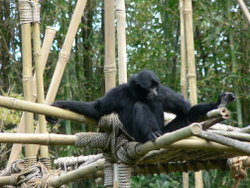Siamang: Difference between revisions
m robot Adding: lt |
Angelina Y. (talk | contribs) No edit summary |
||
| Line 17: | Line 17: | ||
}} |
}} |
||
The '''Siamang''' (''Symphalangus syndactylus'') is an [[arboreal]] black furred [[gibbon]] native to the forests of [[Malaysia]] and [[Sumatra]]. |
The '''Siamang''' (''Symphalangus syndactylus'') is an [[arboreal]], black furred [[gibbon]] native to the forests of [[Malaysia]] and [[Sumatra]]. The largest of the [[lesser ape]]s, the siamang can be twice the size of other gibbons, reaching 1 m in height, and weighing up to 23 kg. The Siamang is the only species in the genus '''''Symphalangus'''''. |
||
The Siamang is distinctive for two reasons. |
The Siamang is distinctive for two reasons. The first is the fact that two fingers on each hand are fused together (hence the name "[[syndactyl]]us"). The second is the large "gular sac", which is a throat pouch that can be inflated to the size of its head, allowing siamangs to make loud resonating calls or songs. |
||
There are two subspecies of Siamangs: the '''Sumatran Siamang''' (''S. s. syndactylus'') and the '''Malaysian Siamang''' (''S. s. continentis'', in peninsular Malaysia). |
There are two subspecies of Siamangs: the '''Sumatran Siamang''' (''S. s. syndactylus'') and the '''Malaysian Siamang''' (''S. s. continentis'', in peninsular Malaysia). The Siamang is the only species of gibbons which occurs sympatrically with other gibbons ([[Agile Gibbon]]s and [[Lar Gibbon]]s) throughout its entire range. |
||
Siamangs can live up to 20 years in captivity. |
Siamangs can live up to 20 years in captivity. |
||
| Line 46: | Line 46: | ||
{{primate-stub}} |
{{primate-stub}} |
||
[[Category:Apes]] |
[[Category:Apes|Siamangs]] |
||
[[Category: |
[[Category:Gibbons|Siamangs]] |
||
[[Category:Fauna of Indonesia|Siamangs]] |
|||
[[da:Siamang]] |
[[da:Siamang]] |
||
Revision as of 06:17, 16 March 2006
| Siamang | |
|---|---|

| |
| Scientific classification | |
| Kingdom: | |
| Phylum: | |
| Class: | |
| Order: | |
| Family: | |
| Genus: | Symphalangus |
| Species: | S. syndactylus
|
| Binomial name | |
| Symphalangus syndactylus | |
The Siamang (Symphalangus syndactylus) is an arboreal, black furred gibbon native to the forests of Malaysia and Sumatra. The largest of the lesser apes, the siamang can be twice the size of other gibbons, reaching 1 m in height, and weighing up to 23 kg. The Siamang is the only species in the genus Symphalangus.
The Siamang is distinctive for two reasons. The first is the fact that two fingers on each hand are fused together (hence the name "syndactylus"). The second is the large "gular sac", which is a throat pouch that can be inflated to the size of its head, allowing siamangs to make loud resonating calls or songs.
There are two subspecies of Siamangs: the Sumatran Siamang (S. s. syndactylus) and the Malaysian Siamang (S. s. continentis, in peninsular Malaysia). The Siamang is the only species of gibbons which occurs sympatrically with other gibbons (Agile Gibbons and Lar Gibbons) throughout its entire range.
Siamangs can live up to 20 years in captivity.
Media
Template:Multi-video start Template:Multi-video item Template:Multi-video end




